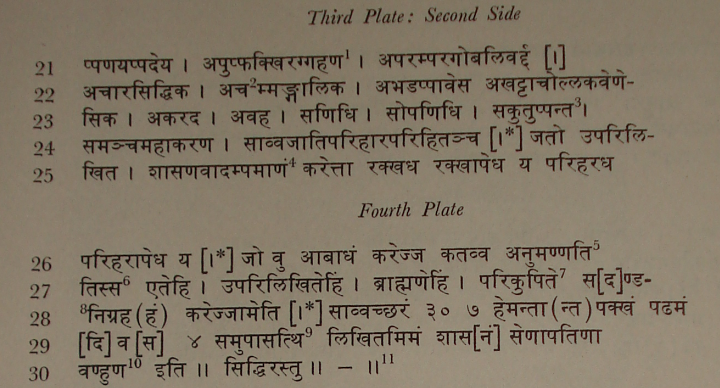|
INSCRIPTIONS OF THE VATSAGULMA BRANCH

TRANSLATION
Success ! Seen. From Vatsagulma-
...By the order of the Dharmamahārāja, the illustrious Vindhyaśakti (II) of the Vākāṭakas, (who is) the son of the Dharmamahārāja, the illustrious Sarvasēna (and) grandson of the Dharmamahārāja, the illustrious Pravarasēna (I), the Samrāṭ, and the son (i.e., descendant) of
Hāritī12, (who was) of the Vṛishṇivṛiddha gōtra and who performed Agnishṭōma, Aptōryāma,
Vājapēya, Jyōtishṭōma13, Bṛihaspatisava, Sādyaskra and four Aśvamēdhas:-
...The Ājñapti14 and soldiers who are employed by us in all departments15 as well as other (touring officials) of noble birth in (the village) Ākāsapadda, which is situated near TākālakkHōppaka in the northern division (mārga) of Nāndīkaḍa, should be caused to be addressed (as follows) :-
_____________________
1 The curve on ṇa seems to have been cancelled.
2 The engraver at first incised da which he later changed to cha.
3 This corresponds to sa-kḷipt-ōpakḷipta in the Sanskrit charters of the Vākāṭakas. See e.g. No. 3,
line 28.
4 I am indebted to Dr. B. Ch. Chhabra for the reading of this expression.
5 The letter after ma has been cancelled.
6 Read tassa.
7 Read parikupitehi veditassa, Cf. No. 3, line 31.
8 In the margin on the left, almost on a level with this line, there is a symbol for 4, denoting the
number of the plate.
9 The last three aksharas of this word are incised over others which have been cancelled.
10 Read Vaṇhuṇā
11 There is an ornamental symbol between these two sets of daṇḍas.
12 The epithet Hāritīputra occurs in the inscriptions of the Kadambas and the Early Chālukyas-
See e.g. the Tālagunda inscription of Kākusthavarman (Ep. Ind., Vol. VIII, p.31) and the Mahākūṭa
inscription of Maṅgaleśa (Ind. Ant., Vol. XIX, p. 16). In later records Hārīti (or Hārīti-pañchasikha)
is represented as a sage. In that case Hārītiputra may mean a disciple of Hārīti. Cf. Sākya-putra
meaning a Buddhist.
13 This record mentions Jyōtishṭōma in place of Ukthya, Shōḍaśin and Atirātra, which are mentioned
in other Vākāṭaka records among the sacrifices performed by Pravarasēna I.
14 Āṇatti (Sanskrit, Ājñapti) is mentioned at the close of copper-plate charters and corresponds to
the Dūtaka mentioned similarly in some charters. He was entrusted with the execution of royal orders,
15 The usual expression in Vākāṭaka grants is Sarvādhyksha-niyōga-niyuktaḥ meaning ‘who are
employed by the order of the General Superintendentâ.
|